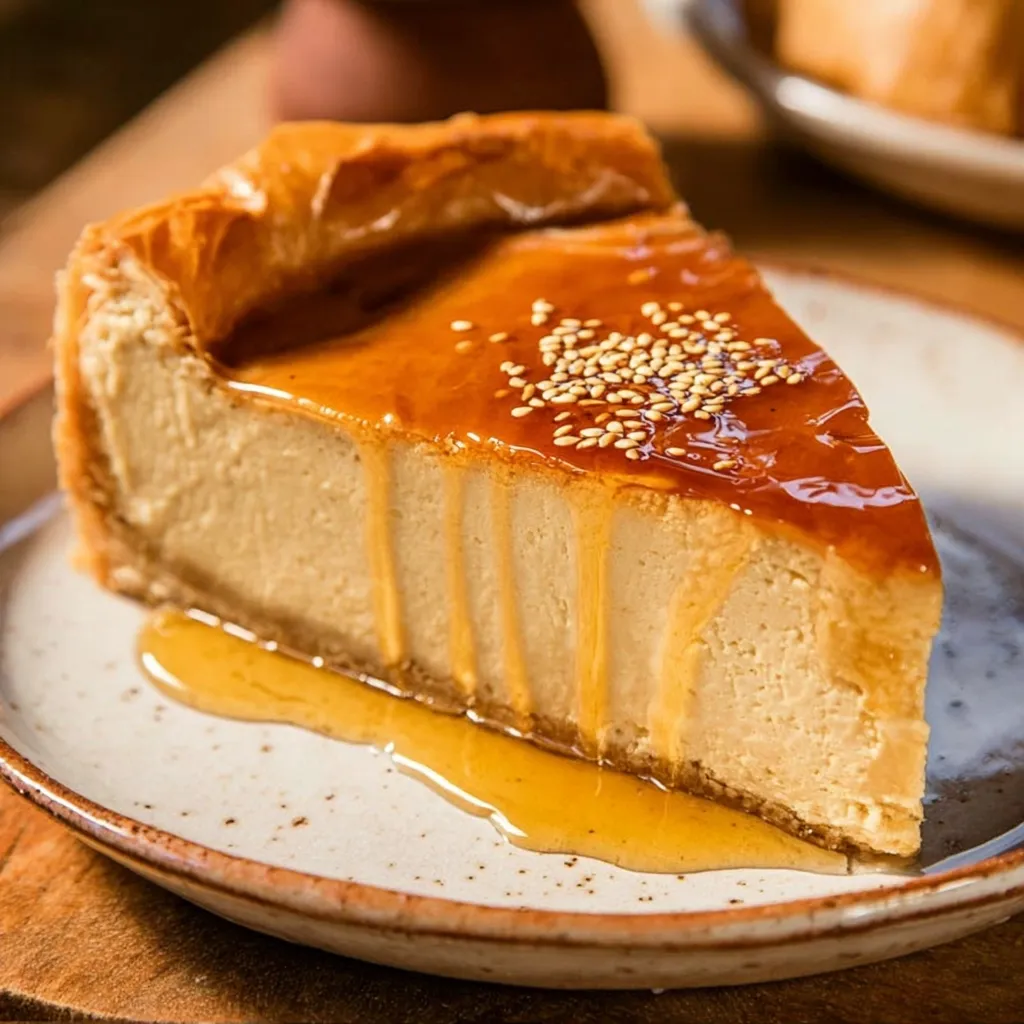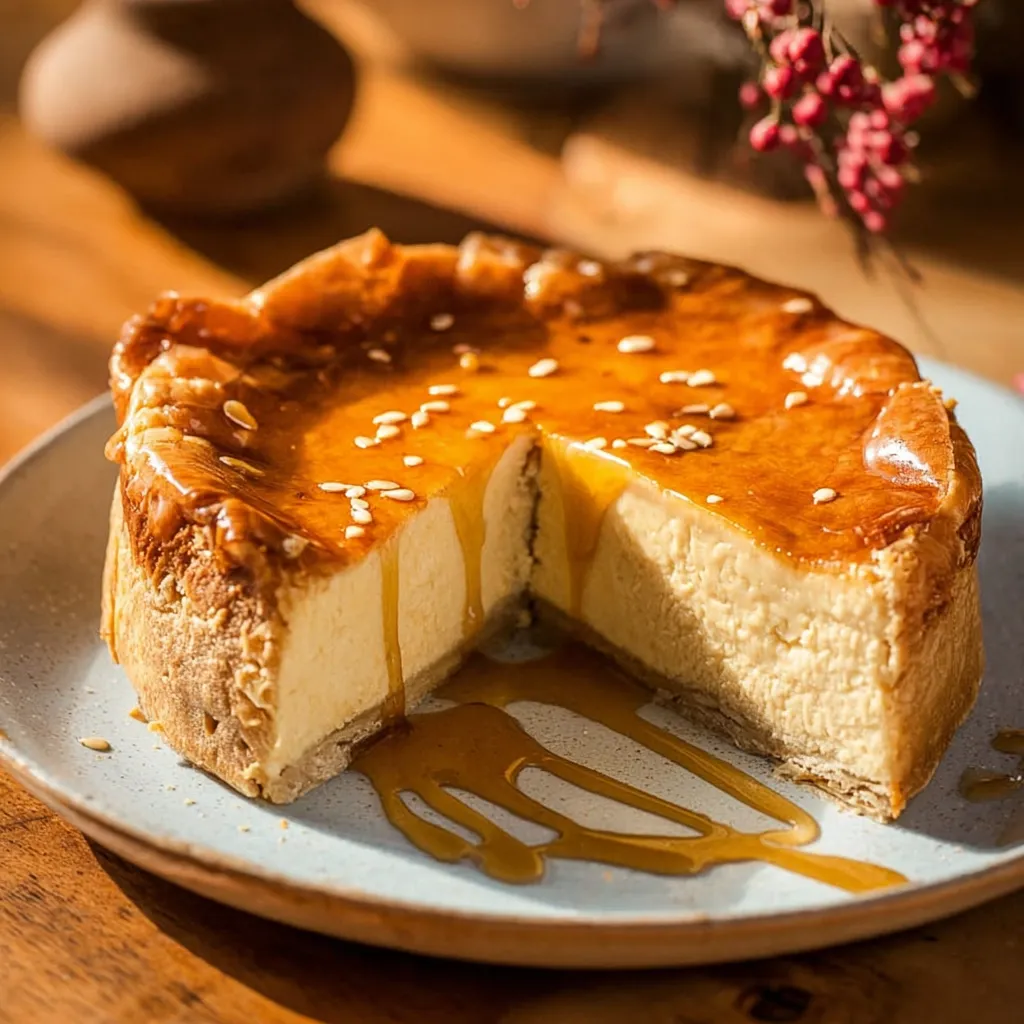 Save
Save
This hearty Greek Melopita has been my secret weapon for impressing dinner guests with minimal effort. The contrast between flaky phyllo layers and sweet honey-infused filling creates a dessert that feels both rustic and elegant at the same time.
I first made this pie during a particularly harsh winter when I was craving something comforting yet special. My Greek neighbor tasted it and declared it reminded her of childhood visits to her grandmother's island home. Now it's become my signature dessert for special occasions.
Ingredients
- Phyllo dough sheets: fresh is amazing but frozen works perfectly when thawed properly according to package instructions
- Unsalted butter: creates that irresistible flaky texture and rich flavor in every layer
- Semolina flour: provides the distinctive creamy yet slightly grainy texture traditional to authentic melopita
- Large eggs: bind everything together while adding richness to the filling
- Granulated sugar: balances the warming spices without overwhelming the honey flavor
- Whole milk: creates the perfect custard consistency — avoid lower fat alternatives
- Ground cinnamon: adds warmth and depth — use Ceylon cinnamon for more delicate flavor
- Ground nutmeg: complements the cinnamon with subtle complexity — fresh grated is worth the effort
- Honey: the star ingredient that gives this pie its signature sticky sweetness — choose a floral variety if possible
- Sesame seeds: provide gentle nuttiness and textural contrast to the soft filling
Step-by-Step Instructions
- Prepare the phyllo base:
- Carefully layer each sheet of delicate phyllo in your baking dish, taking time to thoroughly brush each one with melted butter. Work deliberately but quickly to prevent the phyllo from drying out. The gentle rustling sound of the paper thin dough as you arrange it is part of the sensory experience of making this dessert. This foundation will provide the perfect crispy contrast to your creamy filling.
- Create the semolina filling:
- Whisk your semolina, eggs, sugar, milk and spices with intention, making sure to eliminate any lumps for the smoothest possible texture. The mixture will seem quite liquid at this stage, but trust the process. As it bakes, the semolina will absorb moisture and transform into a luxurious custard. The warm spices should be just noticeable without overpowering the delicate honey flavor that will come later.
- Layer and score:
- Pour your prepared filling over the buttered phyllo base in one smooth motion, allowing it to settle evenly. Add the final phyllo sheet on top, brushing generously with butter to ensure golden browning. Using a sharp knife, score the top layer into diamond patterns about halfway through. This traditional technique not only creates beautiful presentation but allows the honey to penetrate deeply into each slice later.
- Bake to golden perfection:
- Place your assembled pie in the preheated oven and let the magic happen. Your kitchen will gradually fill with the intoxicating aroma of butter, honey and warm spices. Watch for the edges to pull slightly away from the pan and the top to reach a deep amber color. The filling should have just the slightest wobble in the center when gently shaken. Patience during baking rewards you with perfect texture.
- Add the finishing touches:
- While the pie is still warm but not hot, drizzle warmed honey generously over the surface, allowing it to seep into the score marks and around the edges. The sizzling sound as honey meets warm pie is deeply satisfying. Sprinkle with toasted sesame seeds while the honey is still tacky enough for them to adhere. This final flourish adds visual appeal and subtle texture to each bite.

The warming spices in this recipe always transport me back to my first trip to Greece, where I discovered melopita at a tiny family restaurant overlooking the Aegean. The grandmother who made it refused to share her recipe, but after years of experimenting, this version finally captured that magical memory. The scent of cinnamon and honey still makes me think of that sun drenched terrace.
Make It Your Own
This traditional recipe welcomes thoughtful adaptations based on your personal preferences and available ingredients. Consider adding orange zest to the filling for a bright citrus note that complements the honey beautifully. The subtle aromatic quality adds complexity without overwhelming the traditional flavor profile.
Serving Suggestions
Melopita shines when served slightly warm, allowing the honey to remain flowing and the filling to maintain its custardy texture. A dollop of thick Greek yogurt alongside provides a tangy counterpoint to the sweetness. For special occasions, add a sprinkle of crushed pistachios for color and texture, or a light dusting of ground cinnamon to enhance the warming spices already present.
Cultural Significance
In Greek tradition, honey represents prosperity and happiness, making this dessert a meaningful offering at celebrations and family gatherings. The combination of honey and sesame dates back to ancient times when these ingredients were considered symbols of fertility and abundance. By preparing this recipe, you connect with centuries of culinary tradition that honors simple, quality ingredients transformed through thoughtful preparation.
Storage and Reheating
While this pie is at its absolute best when freshly made, leftovers can be preserved and enjoyed later. Store covered at room temperature for up to two days, maintaining the delicate balance between crisp phyllo and tender filling. For longer storage, refrigerate for up to five days, though the texture will gradually soften. When reheating, avoid the microwave which makes the phyllo tough. Instead, warm individual slices in a 300°F oven for 10 minutes to restore some crispness.
Recipe FAQs
- → Can I make Greek Melopita ahead of time?
Yes! You can prepare the Melopita up to a day in advance. For best results, bake it completely, but wait to drizzle with honey until just before serving. Store at room temperature, lightly covered with foil. Warm slightly in a 300°F oven for 10 minutes before adding the honey and serving.
- → What can I substitute for semolina flour?
If you can't find semolina, fine cornmeal or farina (Cream of Wheat) make good substitutes with similar texture. Regular all-purpose flour will work in a pinch, though the custard won't have quite the same slight graininess that makes traditional Melopita special.
- → What type of honey works best for this pie?
Traditional Greek honey varieties like thyme, pine, or wildflower honey work beautifully, offering complex floral notes. However, any good-quality honey will work well. Choose one with a flavor profile you enjoy, as it's a prominent flavor in the finished dessert.
- → How do I prevent my phyllo dough from tearing?
Work with room temperature phyllo for best results. Keep unused sheets covered with a slightly damp kitchen towel while working. Handle gently with dry hands, and don't worry about small tears—they'll be covered by other layers and won't affect the final result.
- → Can I make this dairy-free?
Yes! Substitute the butter with a good quality olive oil or coconut oil, and replace the whole milk with almond or coconut milk. The flavor profile will change slightly but will still be delicious. Ensure your phyllo dough is dairy-free as well (most brands are).
- → How do I know when the Melopita is fully baked?
The pie is done when the top is golden brown and the filling is set but still has a slight jiggle in the center when you gently shake the pan. A knife inserted into the center should come out mostly clean with perhaps a few moist crumbs. The edges will typically bubble slightly when done.
